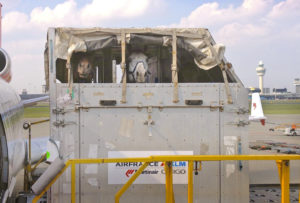
All horses to be imported to the US require a proper health certificate issued by a full-time veterinary officer of the National government of the exporting country, which must state that the horse has:
Been in that country for 60 days immediately preceding importation
Been inspected and found free of contagious diseases
Not been vaccinated with alive, attenuated or inactivated vaccine during 14 days immediately preceding exportation
Not been on premises where African horsesickness, dourine, glanders, surra, epizootic lymphangitis, ulcerative lymphangitis, equine piroplasmosis, equine infectious anemia (EIA), contagious equine metritis (CEM), vesicular stomatitis, or Venezuelan equine encephalomyelitis has occurred during the 60 days immediately preceding exportation
Not been in a country where CEM is known to exist or had any contact with other horses from such a country in the last 12 months
All horses arriving in the US are required to be quarantined while test for dourine, glanders, equine piroplasmosis, and EIA are conducted. The samples get tested at the USDA lab in Ames, Iowa. Any horse testing positive for any of these diseases will be refused entry into the US.
The USDA requires a 3-day quarantine for:
A 3-day quarantine is required for horses coming from one the following countries (not infected with VEE, Venezuelan Equine Encephomylitis or AHS, African Horse Sickness):
Afghanistan, Albania, Australia, Austria, Belgium, Bermuda, British Virgin Islands, China, Czech Republic, Denmark, Estonia, Finland, France, Germany, Greece, Holland (The Netherlands), Hong Kong, Hungary, Iceland, India, Indonesia, Ireland, Israel, Italy, Japan, Jordan, Lebanon, Luxembourg, Macao, Malta, Mexico, Norway, New Zealand, Pakistan, Philippines, Poland, Portugal, Romania, Russia, Scotland, Spain, South Korea, Sweden, Switzerland, Turkey, United Arab Republic (UAE), United Kingdom
The USDA requires a 7-day quarantine for:
A 7-day quarantine is required for horses coming from one of the following countries (VEE has been reported within the last year):
Argentina, Caribbean Islands, Cuba, Bahamas, Jamaica, Haiti, Dominican Republic, Virgin Islands Barbados Trinidad, British West Indies, Dutch West Indies, Guatemala, Belize, El Salvador, Honduras, Nicaragua, Costa Rica, Panama, Columbia, Venezuela, Guyana, Surinam, French Guyana, Ecuador, Peru, Bolivia, Brazil, Uruguay, Paraguay, Chile
The USDA requires a 60-day quarantine for:
A 60-day quarantine is required for horses, coming from a region where African Horse Sickness has been reported during the last 12 months.
In addition to that, mares and stallions older than 731 days, must go from USDA quarantine to a state CEM quarantine facility to receive further treatment and testing. Mares are usually released after 15 days, stallions after 5 weeks.

Check out this helpful and detailed packet explaining CEM Quarantine, courtesy of our friends at WellGrove Quarantine!
EU Import Process
Horses going from the United States to the European Union can either be shipped with permanent or temporary health papers.
Permanent Health Status
To export a horse under the permanent health status, the following is required:
- The horse needs to stay in quarantine for 30 days in any USDA approved facility.
- A vaccination for EEE & WEE (Eastern and Western Equine Encephalomyelitis) is needed not less than 30 days but not more than 180 days prior to export.
- A negative AGID coggins test result is needed within 30 days prior to export.
- For stallions, a test for EVA (Equine Viral Arteritis) is required within 21 days prior to export.
Temporary Health Status
Under the temporary health status your horse is allowed to stay in the foreign country for 90 days. To export a horse under the temporary health status, the following is required:
- A negative AGID coggins test is needed within 90 days of shipment.
- A vaccination for EEE & WEE (Eastern and Western Equine Encephalomyelitis) is needed not less than 30 days but not more than 180 days prior to export.
- For stallions, a negative test result for Equine Viral Arteritis (EVA) is needed within 21 days of export.
- All horses need to have a FEI Passport, Breed registry papers or AHSA papers as well as a copy of these documents attached to the health certificate.
At present no additional testing is required however this may change at any time depending on disease outbreaks. We always keep up us updated with the current health status requirements with the United States Department of Agriculture.
Current EU Import West Nile Virus Vaccination Requirements
Each horse being shipped to the European Union must have an additional certification stating that it was either not vaccinated against West Nile Virus or it was vaccinated against West Nile Virus with an inactivated vaccine on at least two occasions at an interval of between 21 to 42 days apart. The second injection must have been given at least 30 days prior to export departure date.
West Nile is a mosquito-borne virus, which causes encephalitis or inflammation of the brain. It has been found in Africa, western Asia, the Middle East, the Mediterranean region of Europe and most recently in various parts of the eastern US. Mosquitoes acquire the West Nile virus from birds and pass it on to other birds, animals and people. While the virus may infect humans and horses, there is no documentation that infected horses can spread the virus to uninfected horses or other animals. Migrating birds may play a role in spreading the disease. No treatment is currently available for the West Nile virus.
Equine Diseases
CEM — Contagious Equine Metritis
CEM is a transmissible, exotic, venereal disease of horses caused by the bacterium Taylorella equigenitalis. Thoroughbred horses appear to be more severely affected by the disease than other breeds. Because animals may be asymptomatic, the disease is difficult to detect and control. There is no evidence that CEM affects people.
CEM is a serious disease because it is highly contagious. When coupled with the fact that mares can be bred at only certain seasons, CEM can have a devastating effect on equine reproductive efficiency. Should CEM become established in the United States, the horse industry would suffer great economic losses.
CEM is commonly transmitted directly during natural sexual intercourse between undetected CEM-positive breeding mares and stallions. Transmission may also occur indirectly by artificial insemination or fomites, such as contaminated hands or instruments. Outbreaks usually occur at breeding facilities following international horse shipments.
Undetected carrier mares and stallions are the source of infection for acute outbreaks of the disease. During the breeding season, a carrier stallion may infect several mares before the disease is suspected or diagnosed.
The mare cannot be successfully treated until the CEM bacteria clears from the uterus, a process that may take several months. The external genitalia of the mare and the stallion can be treated with disinfectants and antibiotics. Once daily for 5 consecutive days, the external genitalia should be gently scrubbed with 2-percent chlorhexidine in a mild detergent solution and rinsed with warm saline. The external genitalia should then be coated with an antibiotic ointment, such as nitrofurazone. Due to the effectiveness of this treatment, surgical removal of the clitoral sinuses is rarely required.
Vesicular Stomatitis
Vesicular stomatitis is a viral disease that primarily affects cattle, horses and swine. The virus that causes vesicular stomatitis has a wide host range. This disease also occasionally affects sheep and goats. Many species of wild animals, including deer, bobcats, goats, raccoons, and monkeys have been found to be susceptible hosts. Humans can also become infected when handling affected animals.
Vesicular stomatitis is most likely to occur during warm months in the Southwest, particularly along riversides and in valleys.
While vesicular stomatitis can cause economic losses to livestock producers, it is a particularly significant disease because its outward signs are similar to those of foot-and- mouth disease. The clinical signs are also similar to those of swine vesicular stomatitis and vesicular exanthema of swine. The only way to tell these diseases apart is through laboratory tests.
There is no specific treatment or cure for vesicular stomatitis. Owners can protect their animals from this disease by avoiding congregation of animals in the vicinity where vesicular stomatitis has occurred. Mild antiseptic mouthwashes may bring comfort and more rapid recovery to an affected animal. Good sanitation and quarantine practices on affected farms usually contain the infection until it dies out of its own accord.
EP — Equine Piroplasmosis
EP is present in South and Central America, the Caribbean, Africa, the Middle East and Eastern and Southern Europe. This disease is caused by two parasite organisms, Babesia equi and Babesia caballi. Although EP is primarily transmitted to horses by ticks, this bloodborne disease has been spread mechanically from animal to animal by contaminated needles.
EP can have a mortality rate as high as 20 percent among susceptible horses in areas where the disease does not exist, such as the US horse population. Infected horses that survive the infection may carry the parasites for prolonged periods of time but the potential of the disease spreading by tickborne transmission, mechanical transfer or biting insects is minimal if appropriate risk mitigating factors are in place. An effective drug therapy treatment exists for B.caballi; however, a compatible chemotherapeutic drug to treat B.equi is still under development.
Some of the above information was taken from the USDA WebPages. For more detailed information please visit www.Aphis.usda.gov

